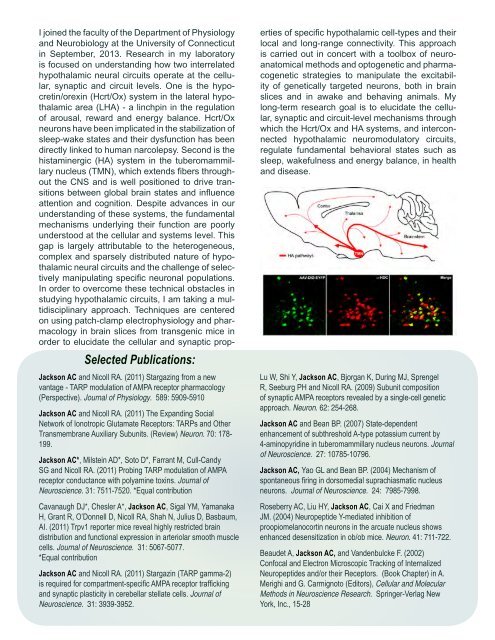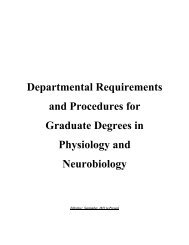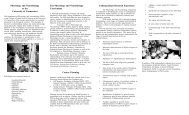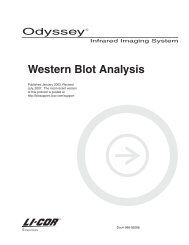Information Brochure (pdf) - Physiology and Neurobiology ...
Information Brochure (pdf) - Physiology and Neurobiology ...
Information Brochure (pdf) - Physiology and Neurobiology ...
You also want an ePaper? Increase the reach of your titles
YUMPU automatically turns print PDFs into web optimized ePapers that Google loves.
Selected Publications:<br />
Jackson AC <strong>and</strong> Nicoll RA. (2011) Stargazing from a new<br />
vantage - TARP modulation of AMPA receptor pharmacology<br />
(Perspective). Journal of <strong>Physiology</strong>. 589: 5909-5910<br />
Jackson AC <strong>and</strong> Nicoll RA. (2011) The Exp<strong>and</strong>ing Social<br />
Network of Ionotropic Glutamate Receptors: TARPs <strong>and</strong> Other<br />
Transmembrane Auxiliary Subunits. (Review) Neuron. 70: 178-<br />
199.<br />
Jackson AC*, Milstein AD*, Soto D*, Farrant M, Cull-C<strong>and</strong>y<br />
SG <strong>and</strong> Nicoll RA. (2011) Probing TARP modulation of AMPA<br />
receptor conductance with polyamine toxins. Journal of<br />
Neuroscience. 31: 7511-7520. *Equal contribution<br />
Cavanaugh DJ*, Chesler A*, Jackson AC, Sigal YM, Yamanaka<br />
H, Grant R, O’Donnell D, Nicoll RA, Shah N, Julius D, Basbaum,<br />
AI. (2011) Trpv1 reporter mice reveal highly restricted brain<br />
distribution <strong>and</strong> functional expression in arteriolar smooth muscle<br />
cells. Journal of Neuroscience. 31: 5067-5077.<br />
*Equal contribution<br />
Jackson AC <strong>and</strong> Nicoll RA. (2011) Stargazin (TARP gamma-2)<br />
is required for compartment-specific AMPA receptor trafficking<br />
<strong>and</strong> synaptic plasticity in cerebellar stellate cells. Journal of<br />
Neuroscience. 31: 3939-3952.<br />
I joined the faculty of the Department of <strong>Physiology</strong><br />
<strong>and</strong> <strong>Neurobiology</strong> at the University of Connecticut<br />
in September, 2013. Research in my laboratory<br />
is focused on underst<strong>and</strong>ing how two interrelated<br />
hypothalamic neural circuits operate at the cellular,<br />
synaptic <strong>and</strong> circuit levels. One is the hypocretin/orexin<br />
(Hcrt/Ox) system in the lateral hypothalamic<br />
area (LHA) - a linchpin in the regulation<br />
of arousal, reward <strong>and</strong> energy balance. Hcrt/Ox<br />
neurons have been implicated in the stabilization of<br />
sleep-wake states <strong>and</strong> their dysfunction has been<br />
directly linked to human narcolepsy. Second is the<br />
histaminergic (HA) system in the tuberomammillary<br />
nucleus (TMN), which extends fibers throughout<br />
the CNS <strong>and</strong> is well positioned to drive transitions<br />
between global brain states <strong>and</strong> influence<br />
attention <strong>and</strong> cognition. Despite advances in our<br />
underst<strong>and</strong>ing of these systems, the fundamental<br />
mechanisms underlying their function are poorly<br />
understood at the cellular <strong>and</strong> systems level. This<br />
gap is largely attributable to the heterogeneous,<br />
complex <strong>and</strong> sparsely distributed nature of hypothalamic<br />
neural circuits <strong>and</strong> the challenge of selectively<br />
manipulating specific neuronal populations.<br />
In order to overcome these technical obstacles in<br />
studying hypothalamic circuits, I am taking a multidisciplinary<br />
approach. Techniques are centered<br />
on using patch-clamp electrophysiology <strong>and</strong> pharmacology<br />
in brain slices from transgenic mice in<br />
order to elucidate the cellular <strong>and</strong> synaptic properties<br />
of specific hypothalamic cell-types <strong>and</strong> their<br />
local <strong>and</strong> long-range connectivity. This approach<br />
is carried out in concert with a toolbox of neuroanatomical<br />
methods <strong>and</strong> optogenetic <strong>and</strong> pharmacogenetic<br />
strategies to manipulate the excitability<br />
of genetically targeted neurons, both in brain<br />
slices <strong>and</strong> in awake <strong>and</strong> behaving animals. My<br />
long-term research goal is to elucidate the cellular,<br />
synaptic <strong>and</strong> circuit-level mechanisms through<br />
which the Hcrt/Ox <strong>and</strong> HA systems, <strong>and</strong> interconnected<br />
hypothalamic neuromodulatory circuits,<br />
regulate fundamental behavioral states such as<br />
sleep, wakefulness <strong>and</strong> energy balance, in health<br />
<strong>and</strong> disease.<br />
Lu W, Shi Y, Jackson AC, Bjorgan K, During MJ, Sprengel<br />
R, Seeburg PH <strong>and</strong> Nicoll RA. (2009) Subunit composition<br />
of synaptic AMPA receptors revealed by a single-cell genetic<br />
approach. Neuron. 62: 254-268.<br />
Jackson AC <strong>and</strong> Bean BP. (2007) State-dependent<br />
enhancement of subthreshold A-type potassium current by<br />
4-aminopyridine in tuberomammillary nucleus neurons. Journal<br />
of Neuroscience. 27: 10785-10796.<br />
Jackson AC, Yao GL <strong>and</strong> Bean BP. (2004) Mechanism of<br />
spontaneous firing in dorsomedial suprachiasmatic nucleus<br />
neurons. Journal of Neuroscience. 24: 7985-7998.<br />
Roseberry AC, Liu HY, Jackson AC, Cai X <strong>and</strong> Friedman<br />
JM. (2004) Neuropeptide Y-mediated inhibition of<br />
proopiomelanocortin neurons in the arcuate nucleus shows<br />
enhanced desensitization in ob/ob mice. Neuron. 41: 711-722.<br />
Beaudet A, Jackson AC, <strong>and</strong> V<strong>and</strong>enbulcke F. (2002)<br />
Confocal <strong>and</strong> Electron Microscopic Tracking of Internalized<br />
Neuropeptides <strong>and</strong>/or their Receptors. (Book Chapter) in A.<br />
Merighi <strong>and</strong> G. Carmignoto (Editors), Cellular <strong>and</strong> Molecular<br />
Methods in Neuroscience Research. Springer-Verlag New<br />
York, Inc., 15-28





